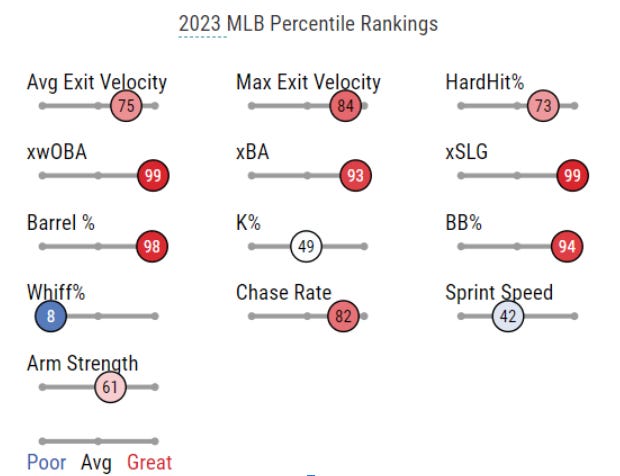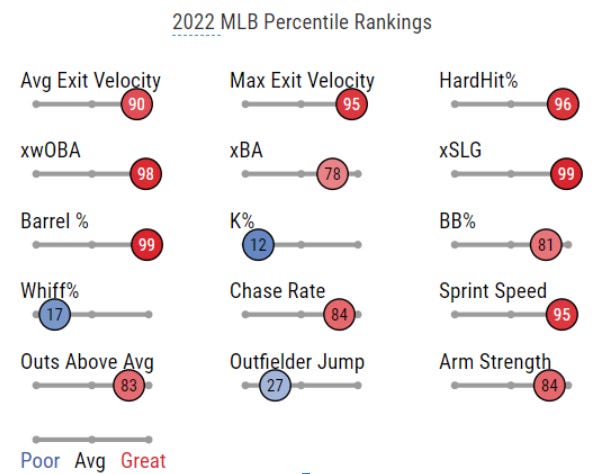Brent Rooker's Breakthrough
The former top prospect has come out swinging in 2023. Can he keep it up?
Brent Rooker has lit it up to start 2023, which is an exciting breakout case because of his prospect pedigree. He was great in college and the minors, winning significant accolades in the process, but he has been constantly moved from club to club in recent years. Is his hot start indicative of the beginning of long-term success, or is he just a flash in the pan?
His Path to Oakland
Brent Rooker has always been under the radar. First, he won Collegiate Baseball Player of the Year with a .387/.495/.810 slash line with 25 HR and 18 SB in 67 games at Mississippi State. Despite this spectacular season in a stacked SEC that produced both College World Series finalists, he had to wait until the 35th pick in the first Competitive Balance Round to be selected by the Minnesota Twins. Then, in the minors, he put up a solid .269/.366/.543 slash across 402 games between 2019 and 2022. He had 65 games with the major-league squad in that time, most of which came in a disappointing 2021 season with a .688 OPS.
The Twins then decided they had seen enough and packaged him with Taylor Rogers in a trade with the Padres for Chris Paddack and Emilio Pagan. The Twins did it for two reasons: they needed rotation help with Chris Archer and Dylan Bundy in their rotation and to make room in the outfield for youngsters Trevor Larnach and Alex Kirilloff in left field, while veteran Max Kepler remained the consistent presence in right field. This decision did not pan out, as Paddack pitched only 22 innings before needing Tommy John, Kirilloff continued to have the wrist problems that have bothered him his whole career, and Larnach has remained mediocre as he continues to adjust to the majors. Meanwhile, Rooker continued to impress in his new team’s minor league system; a .990 OPS with the Padres’ AAA affiliate, the El Paso Chihuahuas (not relevant, just a great name) in 62 games is excellent production despite playing in the extremely hitter-friendly PCL. But apparently, that wasn’t good enough for the Padres, who traded him to the Royals for…Cam Gallagher? Gallagher is a defense-first catcher, destined for a backup role at best, who was waived a bit more than a month after being acquired anyway. A.J. Preller is something.
The last leg of his journey came with the Royals, where he had an electric 1.199 OPS on their AAA affiliate in 20 games. 9 HR too! He was then waived in November, as one does with players of that aptitude, and subsequently claimed by the A’s; they got first dibs on him on the waiver wire as the weakest team in the same league as the Royals. I don’t think I have to name the players the Royals chose to keep on their 40-Man Roster instead to show how ridiculous this decision was. Let’s just say that their RF (MJ Melendez) and DH (Franmil Reyes) might have a lower OPS than Rooker this season. Combined.
The Breakthrough
Brent Rooker has always been an offense-first outfielder with great discipline, posting an 11.5% BB rate in the minors with a reasonable 28.6% K rate. In previous MLB stints, he retained the power - 24 HR/650 - but lost the discipline: a 32% K rate with a 6.7% BB rate won’t cut it. Brent Rooker is different now, though; he improved his discipline while retaining the power.
His BaseballSavant page is a sea of red, with a 97th percentile Barrel rate and 94th percentile BB rate with just a 45th percentile K rate. He’s cut his Chase rate from around 30% to less than 22% while swinging at more pitches in the zone. He currently ranks 11th in walk rate at 15.4% amongst qualified hitters while retaining a strikeout rate that’s dead average. He’s also fifth in total HRs, at 10, with fewer PAs than everyone above him. Brent Rooker could legitimately be an MVP-caliber hitter - he leads the AL in OBP and the entire MLB in SLG and OPS after 27 games.
I chose to use this graph of his overall Hitter Performance from PitcherList to illustrate this. They all are very flattering to his performance thus far, for obvious reasons. I almost included his power chart, which is simply a horizontal line at the top of the graph, but this seems a little more instructive.
Rooker has managed to sustain his elite production throughout the start of the season.
Pitch Performances
There’s a lot to like about his performances against all three pitch types. He sees fastballs 51% of the time and has hit them for 5 HR, a .327 xBA, .680 xSLG, and a .466 xWOBA. The same goes for breaking balls, which he’s faced 35% of the time - 4 HR, .314 xBA, .707 xSLG, .479 xWOBA. The one type of pitch he’s struggling against is offspeed, which he has just a .309 xWOBA against. This struggle manifests itself in being unable to elevate the ball - he has just a 6° average LA despite a 90 mph avg EV, which is higher than his average EV against breaking balls. I’m not sure he’ll continue dominating fastballs and breaking balls in this way - in 2021, he struggled vs. breaking balls and offspeed - but his ability to hit fastballs will serve him well. I wouldn’t be surprised if his performance against offspeed also improves; he whiffs on them less than the other two pitch types.
Player Comparison
Here’s a comparison (of offensive attributes):
It’s never too early to make far too aggressive player comparisons. [BaseballSavant]
The first one is Brent Rooker, as one might guess. Who’s the second one? It’s 2022 Mike Trout. While Rooker lacks the defense, speed, and exit velocity, the mix of great discipline not to chase pitches off the plate while also creating great contact and power off the bat makes for a deadly combo. I’m not saying Rooker will win MVPs or be anywhere near the level of Trout. But with the retention of those abilities alone, he could be a 150 OPS+ hitter who defends at an average level for a corner outfielder in his prime.
Conclusion
Will Rooker keep this up? No. His average EV is the biggest tell of that for me; he doesn’t have the elite exit velocity that indicates he’ll be a 1.000+ OPS hitter yet. But a 140 OPS+ is certainly not out of the question, as long as he can make the necessary adjustments mid-year and stay disciplined at the plate. That patience creates an excellent floor for his power; his BABIP of .345 is incredibly reasonable for how he’s hitting the ball, and an SD(LA) of 24.5 indicates that there’s minimal variability on his Launch Angle, which clearly is in a good spot already with a top barrel rate. I would bet on an All-Star appearance in 2023 and him remaining in contention year in and year out - especially if he’s dealt at the Trade Deadline to a contending team that needs a corner outfielder. Now, it’s time for him to get in the gym and gain some exit velocity. Tyler O’Neill knows what I’m talking about.
Sources:
FanGraphs
BaseballSavant
PitcherList
P.S. Hopefully, I can get the next article out over the next few days. More rookie SP evaluations (Pfaadt and Stone). Exciting.






